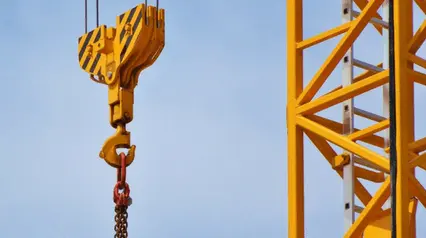What is Crane Safety?
Crane safety is the practice of ensuring a safe working environment for workers and visitors when operating a crane on the worksite. Performing regular crane inspections can help promote crane safety as it can proactively identify risks and hazards that can cause crane accidents and fatalities.
What is a Crane Inspection?
A crane inspection is used for keeping cranes in peak operating condition and ensuring the safety of workers and bystanders. Performing regular crane inspections not only complies with legal regulations and standards like OSHA Standard 1910.179, it also mitigates the risk of costly fines, repairs, and workplace incidents associated with crane usage.
According to the Crane Manufacturers Association of America (CMAA), it is best practice to have only experienced and trained individuals conduct the inspection. Crane inspectors are expected to have formal training in the following:
- Safety and design codes related to overhead cranes
- Federal, state, and local codes and standards
- Safe operating practices of cranes and hoists
- Proper documentation procedures
- Crane and hoist terminologies
3 Common Crane Safety Hazards
Multiple hazards can arise when using large lift systems such as cranes. According to the Bureau of Labor Statistics, in the year 2006 there was a record of over 72 fatalities in the US caused by crane accidents. Crane accidents can be caused by poor training, ignoring crane weight limits, rushed construction jobs, and improper maintenance.
Below are 3 of the common crane accidents that are avoided when identified early during the inspection:
Falling Loads
Falling materials or loads are a major concern when using overhead cranes. They not only result in structural damage but also injury, or worse, death. Falling loads can be caused by various factors such as operator incompetency, two-blocking, slipping, mechanical failures and visual impairment. To mitigate risks of falling materials, maintenance supervisors or plant managers should observe the following:
- Perform regular crane inspections or maintenance checks.
- Have employees wear proper PPE
- Ensure operator operating cranes are well-trained and competent
- Install safety precaution signs
Electrical Hazards
When operating cranes, there is also a risk of it becoming in contact with power sources. Seeing as the crane is mostly made of metal, there is risk of electrocuting all workers in the vicinity. Crane accidents caused by electrical hazards can be avoided if safety protocols and preventative measures are in place. Crane operators should be well informed of potential danger zones and the proper work practices in working near power lines or any exposed energized area. Clearly mark danger zones with barriers, fences, or tape.
Overloading
This occurs when crane’s weight limits are ignored. Exceeding the crane’s operational capacity can put the crane mechanism to stress and lead to irreversible damage that can be quite costly. Most commonly, overloading is due to human error. Specifically when operator’s heavily rely on their instinct in determining whether a load is too heavy for the crane. To prevent this from occurring, ensure that the operator is competent and has a clear understanding of load dynamics, lifting capacities, and safety protocols.
3 Types of Crane Inspections
According to OSHA, ASME (American Society of Mechanical Engineers), and CMAA standards, maintenance supervisors or plant managers are required to perform three different types of inspections throughout the lifetime of crane equipment.
Initial Inspection
OSHA Standard 1910.179 requires all new and altered cranes to be inspected prior to initial use. Appointed or authorized personnel will conduct an inspection of the crane’s components to check its installation and functions.
Frequent Inspection
This is done through visual and operational inspection which is performed on a monthly or weekly basis, depending on the usage of the crane. Frequent inspections involve checking of hoist brake, wire rope, load chain, and the hook and latch to see if there are any abnormal sounds or damage in the mechanisms.
Periodic Inspection
Like frequent inspections, the frequency of conducting periodic inspections depends on the usage of the crane. Cranes not used in more than a month but used within the last six months will be required to undergo a periodic functional test inspection prior to its next use. Periodic inspections entail checking for the following:
- Deformed, cracked, or corroded members
- Loose bolts or rivets
- Cracked or worn sheaves and drums
- Worn, cracked, or distorted parts such as pins, bearings, shafts, gears, rollers, and locking and camping devices
- Excessive wear on brake system parts, linings, pawls, and ratchets
- Load, wind, and other indicators over their full range, for any significant inaccuracies
- Gasoline, diesel, electric, or other power plants for improper performance or noncompliance with applicable safety requirements
- Excessive wear of chain drive sprockets and excessive chain stretch
- Electrical apparatus and signs of pitting or any deterioration of controller contactors, limit switches, and push-button stations
Crane Inspection Software vs Paper-based Crane Inspections: What’s the Difference?
Routine crane inspections are integral to keeping active cranes in peak operating condition. They play a vital role in helping businesses achieve these four goals:
- Ensuring the safety of crane operators
- Strengthening compliance to OSHA, ASME, and CMAA standards
- Extending the life of overhead cranes
- Reducing costly downtime of cranes
Crane inspections are typically outsourced to professional crane inspection service businesses because these services help implement a laser-focused maintenance program, which can be hard to achieve internally since management tends to cater to other aspects of the business. With your expertise, you offer business owners peace of mind, assuring them that they have done their due diligence in keeping crane operations safe while also adhering to strict crane safety regulations. You also provide them helpful insights on how they can keep their operations safe and compliant in the long run.
There are generally two ways crane inspections are performed today: through paper checklists and through paperless means. Let’s take a look at these two methods in practice and see the differences between them.
What Crane Inspections Look Like With Paper
Here’s how crane inspectors often complete inspections with a paper checklist:
- Crane inspector uses a printed crane inspection checklist to log findings during the inspection.
- If there’s a noted defect on the overhead or mobile crane, the operator immediately takes a picture of it with a camera or writes a note to detail the findings. The operator then tags the cranes for downtime service.
- Once the inspection is completed, the operator collates the information gathered during the inspection and manually re-enters them into a computer to create a crane inspection report.
- Once the report has been finalized and approved by the management, it is then printed and delivered to the crane owner for recordkeeping. The document also serves as a point of discussion so they can determine how to address the findings.
As you can see, paper-based inspection poses challenges that you may have already noticed in your crane inspectors’ everyday workflow. Challenges include the extra time spent collating necessary documents to create a report, piles of paperwork in your office, and delays in communicating crane safety issues.
As one of the main people who manage crane safety in your workplace, you may have asked yourself if it’s time for a change and considered crane inspection software as a solution. If this is the case, we’ll share with you the advantages you and your crane operators can enjoy with crane inspection software. With the demand for crane inspection services increasing every year, the importance of crane inspections can’t be emphasized enough. With crane inspection software, you can finally help uplift the quality standards of your inspectors’ work.
SafetyCulture Marketplace: Your One-Stop Work Gear & Equipment Shop
Improve safety in your workplace with SafetyCulture Marketplace as your one-stop shop for all work gear and equipment needs. Get on-demand access to top quality and specialized work gear from trusted equipment brands in the industry—all in one centralized location. Raise the bar of safety and efficiency by empowering employees to request what they need with just a few taps, anytime and anywhere!
Crane Inspection Tool
On the other hand, here’s how crane inspections look like with businesses who use digital means:
- Crane inspector uses a mobile device (could be a smartphone or tablet) and uses a pre-uploaded, standardized digital crane inspection checklist for the inspection. Should there be any findings, the inspector uses the same device to take pictures or write notes, which are automatically attached to the checklist.
- Once the inspection is done, a comprehensive report is automatically generated by the crane inspection software. With the software, a workflow can be set wherein the report can automatically be sent to the client and to other key recipients.
- The inspector can then immediately discuss results and provide recommendations to the client without spending extra time finalizing the report.
Based on this workflow, you may have noticed that the inspector saved time with the administrative parts of the inspection and was able to quickly focus on providing solutions to the client.
FAQs About Crane Inspection Checklist
A crane inspection checklist is a structured document that outlines the steps and criteria for assessing the condition and safety of a crane. It helps ensure that cranes are in proper working order and meet safety standards.
Trained and qualified personnel, often known as crane inspectors, are responsible for conducting crane inspections. These individuals should have a thorough understanding of crane operation, maintenance, and safety standards.
Yes, a crane inspection checklist can typically be customized to suit specific crane types, models, and operating conditions. It’s important to tailor the checklist to address the unique features and potential risks of each crane.



